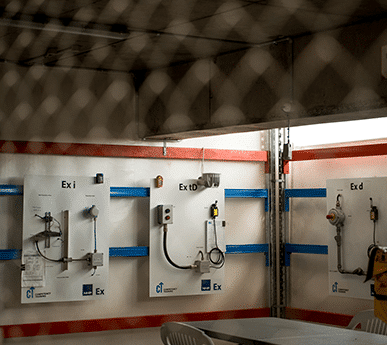Some Known Factual Statements About Roar Solutions
Some Known Factual Statements About Roar Solutions
Blog Article
Getting My Roar Solutions To Work
Table of ContentsThe Ultimate Guide To Roar SolutionsNot known Facts About Roar SolutionsAn Unbiased View of Roar Solutions
In such an ambience a fire or surge is feasible when 3 fundamental conditions are met. This is usually referred to as the "harmful area" or "combustion" triangular. In order to safeguard installations from a potential surge a method of evaluating and categorizing a possibly dangerous location is called for. The purpose of this is to make certain the right option and installment of devices to eventually protect against an explosion and to make sure security of life.
(https://linktr.ee/thomascarrillo4740)
No devices should be installed where the surface area temperature of the equipment is more than the ignition temperature level of the offered danger. Below are some common dirt dangerous and their minimum ignition temperature level. Coal Dust 380C 225C Polythene 420C (thaws) Methyl Cellulose 420C 320C Starch 460C 435C Flour 490C 340C Sugar 490C 460C Grain Dirt 510C 300C Phenolic Material 530C > 450C Aluminium 590C > 450C PVC 700C > 450C Soot 810C 570C The likelihood of the threat existing in a focus high enough to create an ignition will differ from place to place.
In order to classify this danger a setup is split right into areas of threat depending upon the quantity of time the harmful is existing. These areas are described as Areas. For gases and vapours and dusts and fibers there are 3 zones. Area 0 Zone 20 A hazardous atmosphere is highly most likely to be present and may be existing for long durations of time (> 1000 hours annually) or perhaps continuously Zone 1 Zone 21 A hazardous environment is possible yet unlikely to be present for extended periods of time (> 10 450 C [842 F] A classification of T6 means the minimal ignition temperature is > 85 C [185 F] Dangerous area electrical tools maybe developed for usage in higher ambient temperatures. This would showed on the score plate e.g. EExe II C T3 Ta + 60C( This means at 60C ambient T3 will not be surpassed) T1 T1, T2, T3, T4, T5, T6 T2 T2, T3, T4, T5, T6 T3 T3, T4, T5, T6 T4 T4, T5, T6 T5 T5, T6 T6 T6 A T Class ranking of T1 suggests the maximum surface temperature level created by the instrument at 40 C is 450 C. Thinking the linked T Course and Temperature score for the equipment are proper for the area, you can always make use of a tool with an extra rigorous Division ranking than required for the location. There isn't a clear response to this concern sadly. It really does depend on the kind of tools and what repair services need to be brought out. Equipment with certain test procedures that can't be done in the area in order to achieve/maintain 3rd party ranking. Need to return to the factory if it is before the tools's solution. Area Fixing By Authorised Employee: Difficult screening may not be needed nevertheless details treatments may need to be complied with in order for the equipment to preserve its 3rd event ranking. Authorised employees need to be employed to carry out the work correctly Repair service should be a webpage like for like replacement. New component must be taken into consideration as a straight replacement calling for no special screening of the equipment after the repair is total. Each piece of tools with a hazardous ranking must be evaluated separately. These are laid out at a high level listed below, but also for even more comprehensive info, please refer straight to the guidelines.
Roar Solutions Can Be Fun For Anyone
The tools register is a detailed database of equipment documents that includes a minimum collection of fields to determine each thing's place, technical criteria, Ex category, age, and ecological data. The ratio of In-depth to Shut evaluations will certainly be determined by the Equipment Threat, which is analyzed based on ignition risk (the possibility of a source of ignition versus the probability of a combustible environment )and the hazardous area classification
( Zone 0, 1, or 2). Implementing a robust Risk-Based Inspection( RBI )strategy is vital for guaranteeing compliance and safety in taking care of Electric Equipment in Hazardous Locations( EEHA).
The smart Trick of Roar Solutions That Nobody is Discussing

In terms of explosive danger, a hazardous location is an environment in which an eruptive ambience exists (or may be anticipated to be present) in amounts that require special precautions for the construction, setup and use of equipment. hazardous area electrical course. In this article we explore the challenges encountered in the office, the danger control steps, and the required proficiencies to work safely
These compounds can, in particular problems, develop explosive environments and these can have major and tragic consequences. Most of us are acquainted with the fire triangle remove any kind of one of the three elements and the fire can not occur, yet what does this mean in the context of unsafe locations?
In a lot of instances, we can do little concerning the levels of oxygen airborne, but we can have substantial impact on sources of ignition, for instance electrical equipment. Hazardous locations are documented on the unsafe area category drawing and are recognized on-site by the triangular "EX LOVER" indicator. Here, among various other essential information, areas are divided into three types relying on the threat, the probability and duration that an eruptive ambience will exist; Area 0 or 20 is considered the most harmful and Area 2 or 22 is deemed the least.
Report this page